by Mary Howard

On 9/26/19, our #G2great team happily welcomed Ralph Fletcher back as our guest host for the second time. Ralph first wowed us on 4/13/19 with Joy Write: Cultivating High-Impact Low-Stakes Writing (Heinemann, 2017). When word of his new book hit the professional airwaves we all knew that we wanted to extend another invitation: Focus Lessons: How Photography Enhances the Teaching of Writing (Heinemann, 2019). We love it when our gut level instincts transform into a twitter chat blessing.
Your #G2Great co-moderators had the honor of reading Ralph’s new book pre-publication, an opportunity that multiplied our excitement. I still recall opening Focus Lessons on my computer for the first time at 14,000 feet. The introduction drew me in as he likened the jumbo lens of his camera to the stories he crafts on his laptop. (p xi) It was the first time I’ve ever finished a book in one day, thanks to long flights and an unwavering enthusiasm for photography, writing, and Ralph Fletcher. I scurried across inspired pages at warp speed, rereading craft lessons on pages 32-76 twice. I was smitten!
Focus Lessons is unlike any book I’ve ever read before. First, Ralph shares photography lessons he has learned and then shows us his learning in a stunning visual playground where the fruits of his labor beckon a long gaze. But Ralph isn’t content to leave us sitting on the edge of our visual delight. He then leads us on a journey where photography and writing converge in glorious union. In his words, “It turns out that photography can illuminate the craft of writing and help us understand it in a whole new way.” (p xiv)
What better way to add to those understandings than through Ralph’s words? In a phone interview 9/23/19 I asked Ralph this question:
What motivated you to write this book? What impact did you hope that it would have in the professional world?
As I’m learning about photography very much in the role of a student, it was really striking to me how much the instructors in photography were talking about things that seemed very much like writing: sense of detail; tension; story; point of view, angle. Time and time again, I said to myself, “They could be talking about writing. They are talking about writing.” I think that there’s a lot of common ground there and my hope is that my book will encourage language arts teachers to open the door and begin to look at the visual world, specifically photography, as a way to enrich our teaching of writing. The visual world of photography is a world that kids are very familiar with.
While I’d love to detail each photographer-writer inspired idea that Ralph generously shares in his book, I couldn’t possibly do his brilliance justice. I thought that instead I’d create my own visual gallery of the twitter inspired image-words merger so our #G2great chat can provide an added layer. This first tweet is a wonderful starting point. We find ourselves at a crossroads in education where the instructional pace has reached an all-time high. Facing the misguided attempt to squeeze as much as we can into precious limited minutes, Ralph wisely reminds us to savor the experience as we help students to imagine, capture and reflect on thinking at a deeper level. This was a big picture message across his book and our chat.
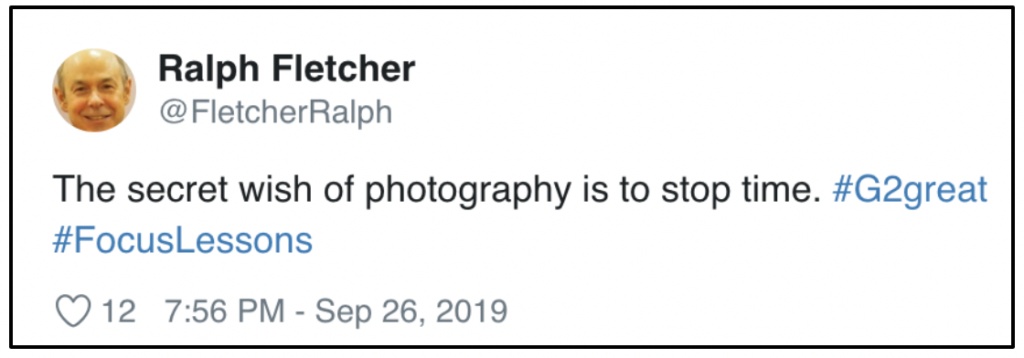
With that stop time message at the forefront of our thinking, I’m going to use Ralph’s #G2Great tweets to create seven Twitter Focus Lessons that will both reinforce and extend his beautiful book:
Ralph Fletcher Twitter Focus Lesson #1 KNOW YOUR “WHY”
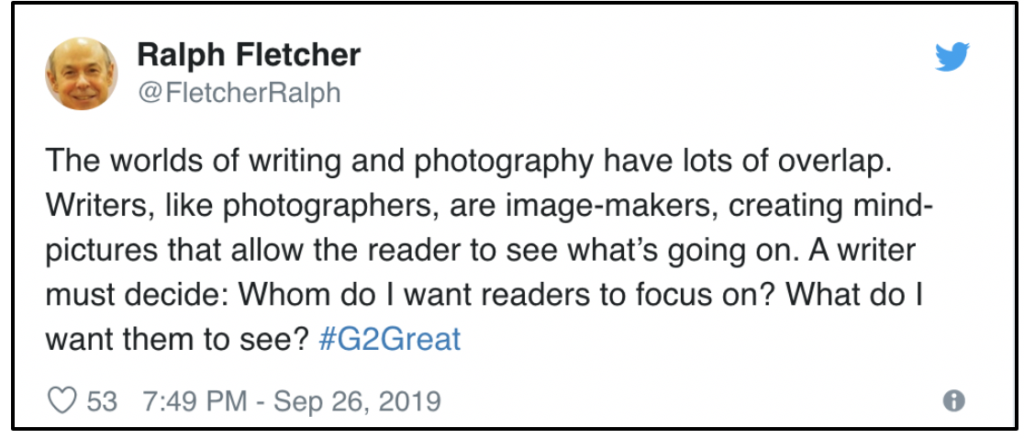
If any semblance of doubt was in the minds of our #G2great chat family that there is a connection between photography and writing, Ralph alleviated those thoughts as he clearly describes this connection. As I think about the mind-pictures that a photograph can inspire, Ralph also beautifully draws our attention to the decisions writers make that are closely related.
Ralph Fletcher Twitter Focus Lesson #2: RELINQUISH CONTROL
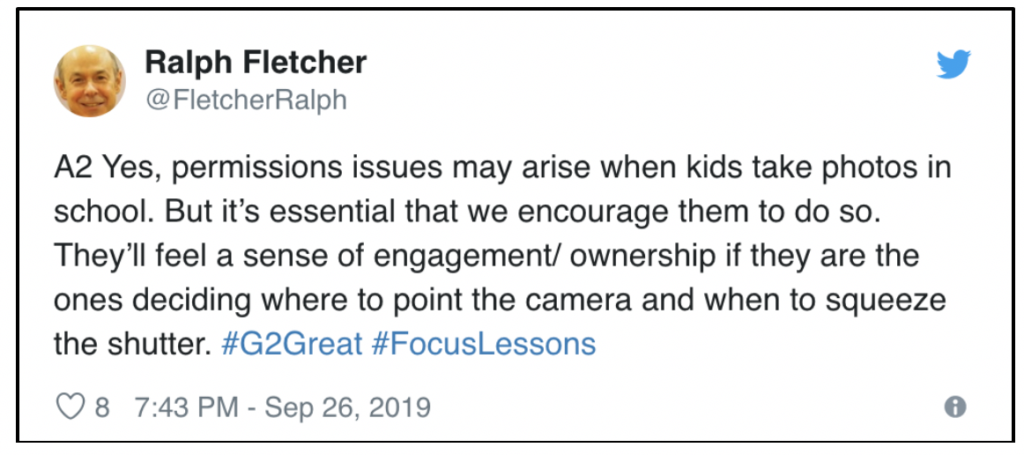
One of our questions invited teachers to contemplate challenges we might face. When the issue of permissions came up, Ralph encouraged us not to allow this to become a roadblock and highlights the impact when we make student ownership a priority. Just as we empower students to take control of their own learning, we can view images in the same way. Our thoughtful lessons begin this handover that will later support writing decisions.
Ralph Fletcher Twitter Focus Lesson #3: EMBRACE PROCESS
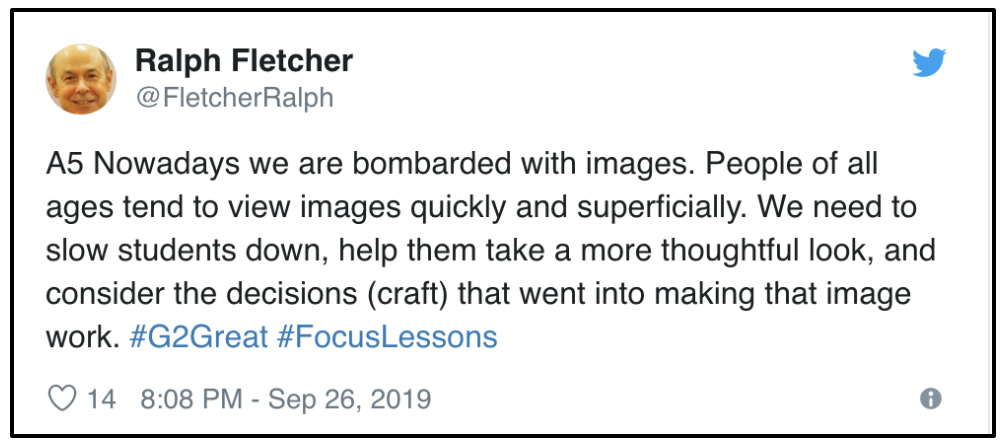
Ralph illustrates the danger of surface level thinking while asking us to acknowledge the power potential of close viewing of images. Just as we encourage students to zoom in on their writing choices, we can also use images as mentor texts and then transfer this thinking to writing. The deep thinking of viewing can then become a pathway to the deep thinking we want when students put words on paper.
Ralph Fletcher Twitter Focus Lesson #4: LINGER IN THE MOMENT
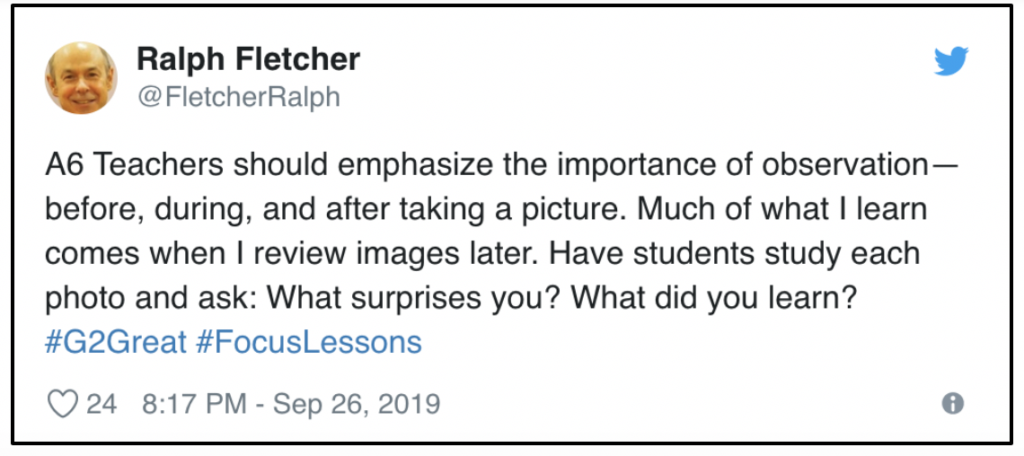
Ralph asks us to embrace process and take advantage of opportunities to encourage students to ponder each step of photograph viewing across all stages. By encouraging “study” and asking questions we can help students put into words what will later be transferred to paper. This thinking time will then offer a forum to verbalize their ideas in ways that will lift this viewing process and ultimately translate into their writing.
Ralph Fletcher Twitter Focus Lesson #5: INVITE BRIEF DESCRIPTORS
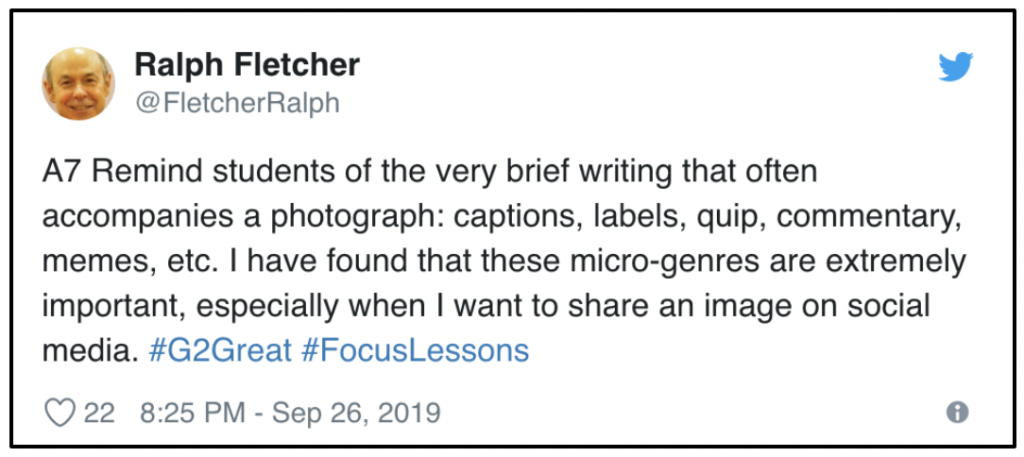
Ralph has a way of helping us identify things that we have done before in such a beautiful way. His description of using “micro-genres” that we find are common on twitter can be a wonderful first step to this viewing-writing connection. It occurs to me that this would offers a supportive scaffold to this merger as we invite written captions that will capture big ideas first.
Ralph Fletcher Twitter Focus Lesson #6: LEAVE A PAPER TRAIL
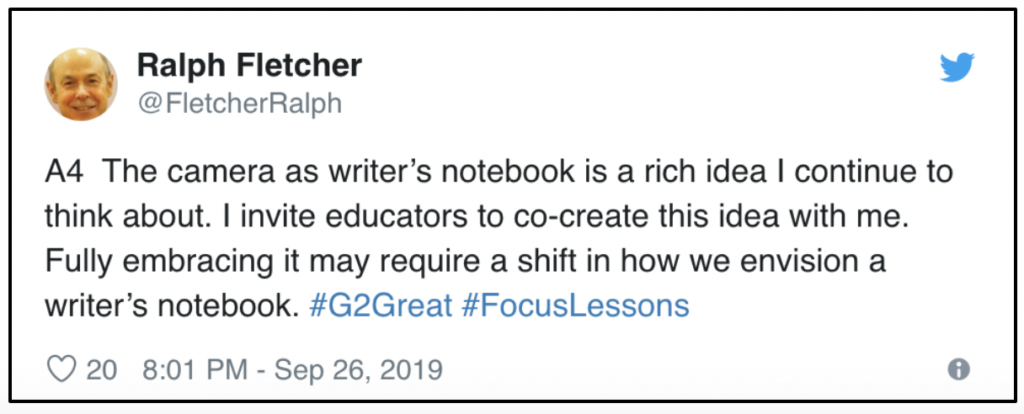
Ralph’s twitter message is a perfect segue between taking a photograph and using that image as an entry point to writing or a reflection to deepen that writing. The combination of close viewing and words offers a way to leave a visual trail that can then support the writing. Supporting this shift between images, reflections and writing can become a beautiful thinking marriage.
Ralph Fletcher Twitter Focus Lesson #7: THE GENTLE NUDGE

It seemed very fitting that those first three words were all in capitals so that our attention would be drawn to his message. I can envision classrooms where this photographer-writer merger would become a lock-step view so his cautionary words are an important reminder. Just as we encourage writing that brings student passions to life, we do the same with images.
Now that I’ve shared our Twitter focus lessons, let’s return to Ralph’s words of wisdom in his second interview question.
What are your BIG takeaways from your book that you hope teachers will embrace in their teaching practices?
It’s really two things. First of all, I really do believe and I think it’s almost indisputable, that the world is becoming more visual. The visual world of photography is a world that kids are familiar with in that they’re taking pictures all the time. When we draw on that world and the language of that world, we’ll find that it’s a language that kids are familiar with too. We could find more accessible, more tangible and more concrete ways for describing some of the craft of writing so that kids will understand it in a new way. Another big idea in the book is that I really do think that I’m sort of known for championing the idea of the writers notebook. It’s pretty clear that our kids today are using their cell phones as writers notebooks. They’re using it to react to the world. They’re collecting things. And they’re doing this with real purpose and often for a real audience and sometimes just to be playful. These are all things that we really work hard to get kids to do in their own writers notebook. I think that we could start by changing the way that we see what kids are doing with all the photographs they’re taking.
Since I opened our Twitter Focus Lessons with a big picture message, I’d like to close with one! In his tweet Ralph elevates our understandings with those three words: Photography IS writing. His description of photography as “writing with light” helps us to understand the tremendous benefits of this process in such a lovely way.
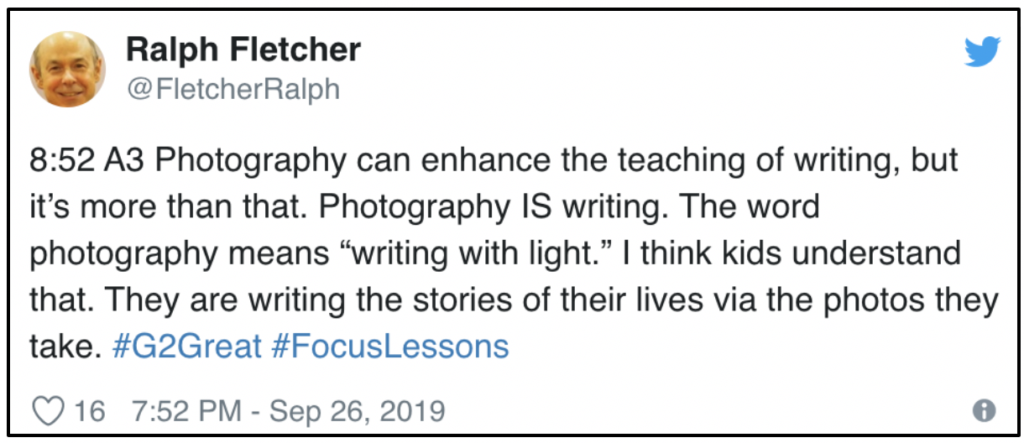
The depth of thinking that Ralph is wisely proposing is illuminated by two examples he shared on #G2great. Take a moment to look at how the two versions of a single experience can change the way we think about those experiences and ultimately the writing that we might do. As I looked at the pictures together, I couldn’t help but envision this thinking transfer.

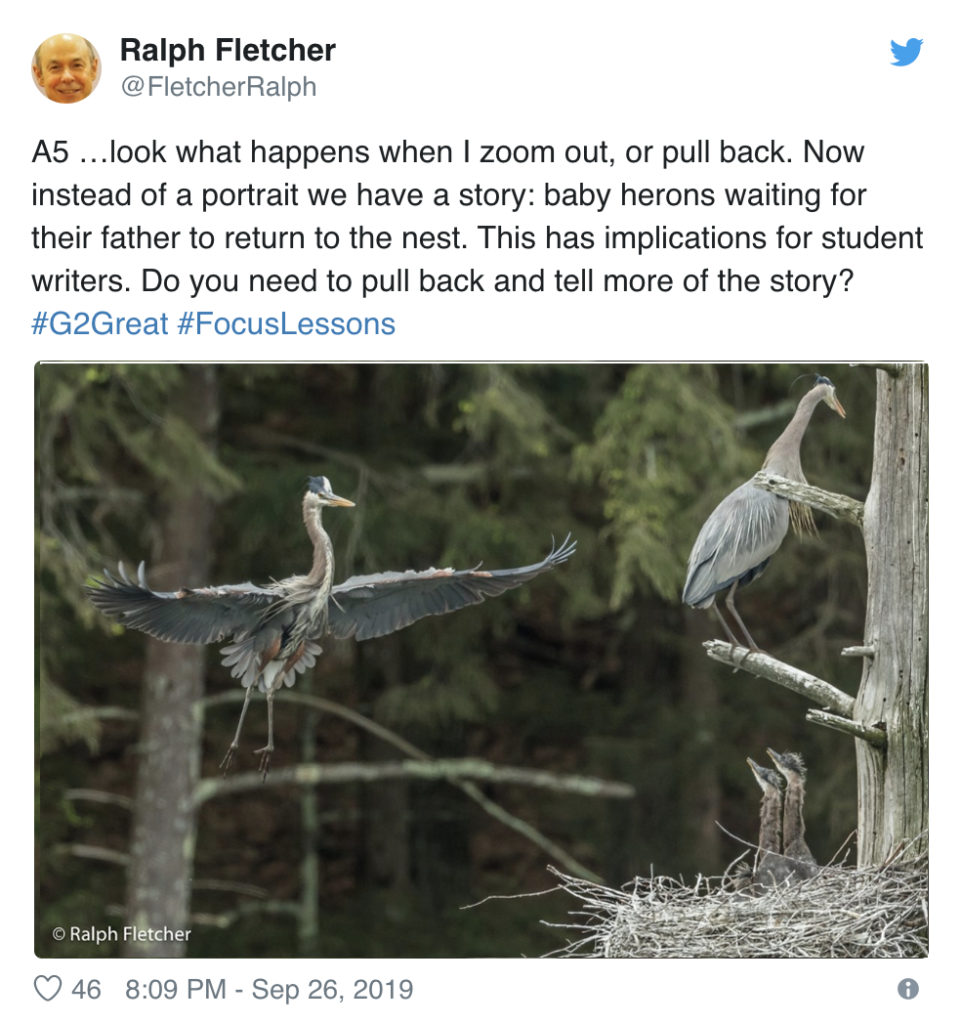
In this final tweet, Ralph brings us back to the link between a photograph and writing. Just as the photographer is creating a story, we can translate that visual story into a written story.
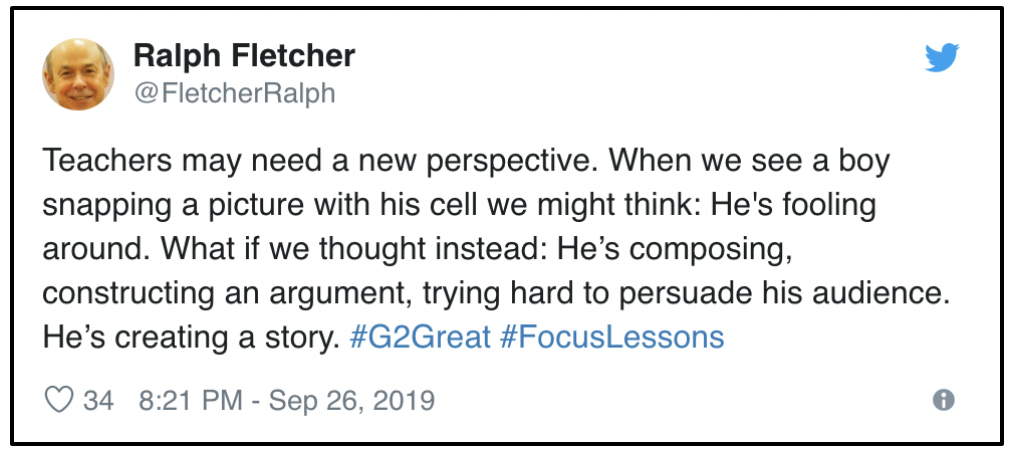
My Closing Thoughts
Through his detailed overlap between photography and writing, both in his book and in our #G2great chat, we do indeed begin to understand in a whole new way. This thoughtful overlap between images and words serves to lift our understandings about photography while deepening understandings about the writing process. Ralph beautifully describes this overlap as we learn what most of us have not been privy to until reading this book:
“The central metaphor of this book involves ways in which the craft of photography mirrors the craft of writing. Both activities involve the creative process. Both involve self-expression. Both allow an individual to represent a slide of the world and comment upon it. Both require craft/technique to be successful. As we will see, the language of photography – a language that is modern and tangible – has a great deal in common with the language of writing.” Page 29
And so as I close this post, I want to return to Ralph Fletcher’s words of wisdom as he responds to our third question.
What is a message from the heart you would like for every teacher to keep in mind?
One thing I want teachers to keep in mind is that oftentimes language arts teachers, and I would include myself I this, tend to be text people. We really savor words, metaphors, and powerful language. Some of us, and again I would include myself in this, have been a little bit resistant or even maybe slightly hostile toward the visual world. If kids in our classrooms are sitting there drawing or doodling, we feel like they’re wasting time. As we move forward, language arts teachers will still value texts and words since that will never go away, but I think that the visual world can enrich what we’re already doing. I would hope that teachers could be receptive and open about that and say, “Gee, I wonder if this could breathe some new life into my language arts program.”
Thank you for helping us all breathe new life into our teaching, Ralph. We are so inspired to begin this beautiful photography-writing journey.
Some #G2Great chat inspiration for Focus Lessons
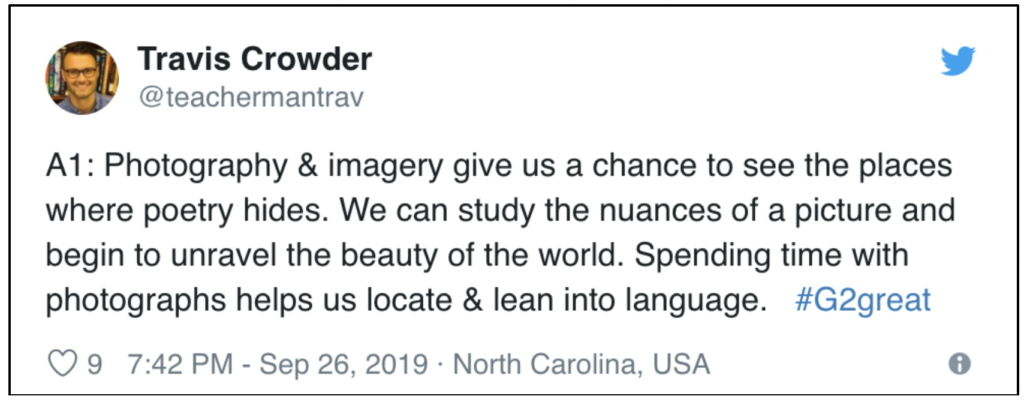
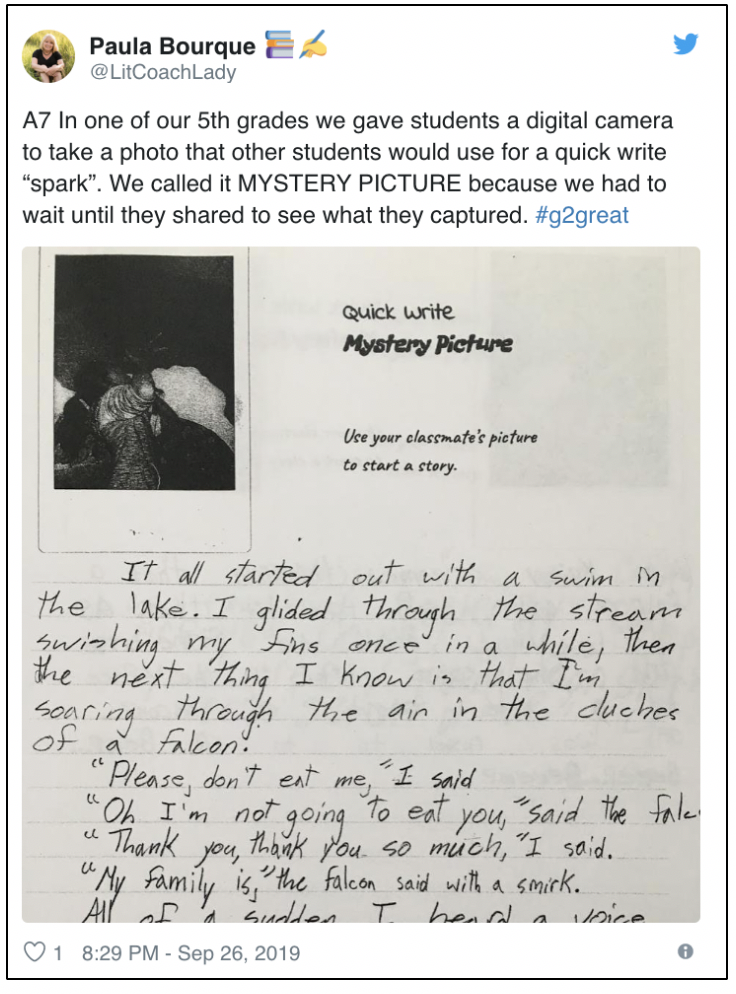
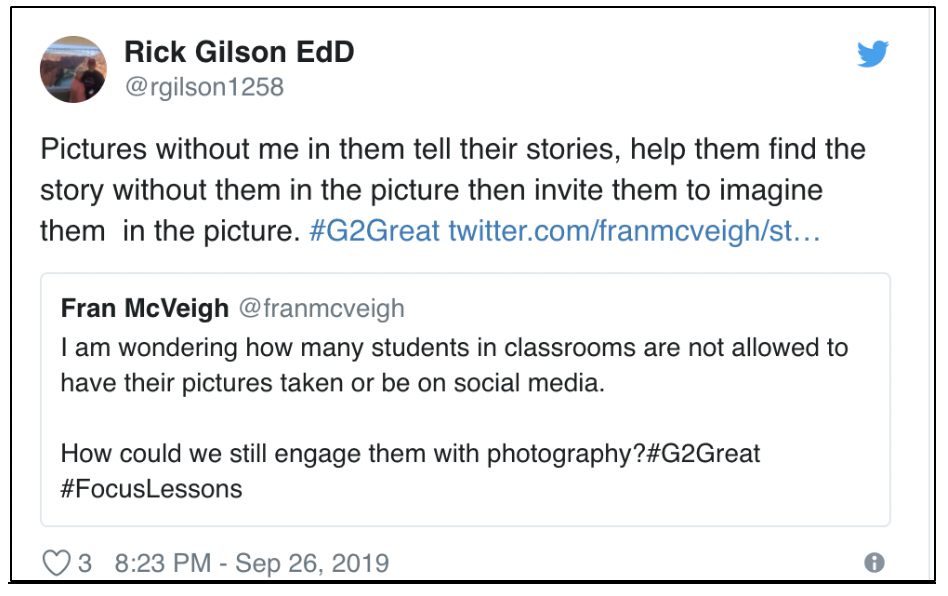
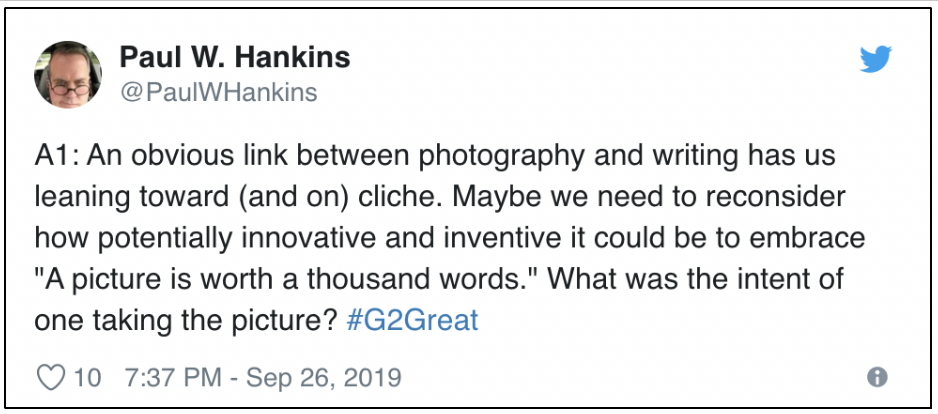

FOCUS LESSON LINKS
Checking In with Ralph Fletcher: On Writing & Photography (Interview with James Preller)
Heinemann Blog: Enhancing Writing Through Photography